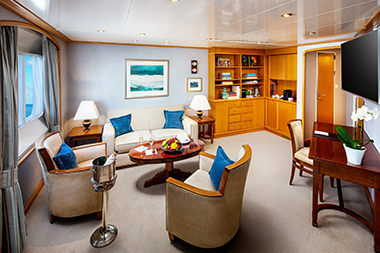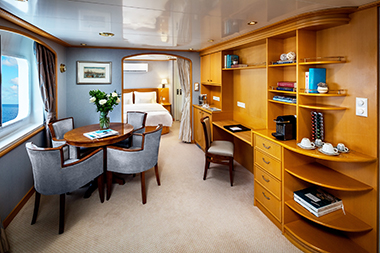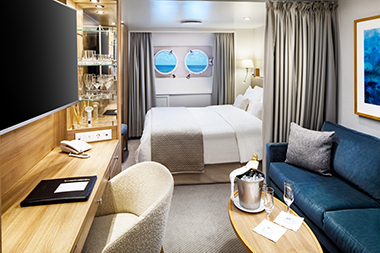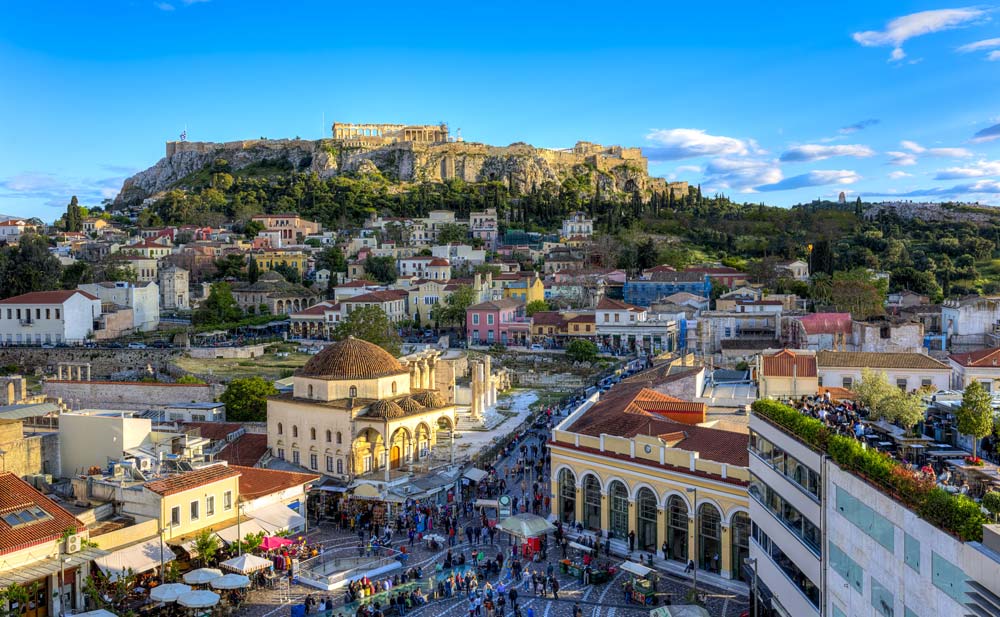
Piraeus, roughly translating to “the place over the passage”, is an important Greek port located within the Athens agglomeration, in the Attica Basin. It is 12 kilometers from the municipality of Athens, considered the fourth largest and is the third most populous amongst all the municipalities of Greece. Now a peninsula, Piraeus, originally a rocky island, was developed in early 5th Century B.C. when it was initially designated as Athens’ import and transit trade port. It is the largest marine-based shipping center of Greece, one of the largest ports in Europe, and considered the second largest passenger port in the world. Inhabited since the 26th Century, it wasn’t until the 6th Century B.C. that Piraeus began catching attention. The land of Piraeus was essentially impassable, flooded by the sea most of the year until centuries passed and the flooding ceased. By the 5th Century B.C. it became a navy base for the Athenian fleet for the natural harbors and the strategic potential they carried. Athenian general and politician Themistocles fortified Piraeus’ three harbors Kantharos, Zea and Munichia, created ship houses and completed his walls in 471 B.C., which led to the port becoming a great military and commercial harbor. There are many archaeological sites, points of interest and entertainment available in Piraeus. Most famous for its tavernas and cuisine, several popular events take place in Piraeus, such as the Ecocinema International Film Festival, the Maritime Festival, the Piraeus Rock Wave Festival and the Three Kings’ Way Festival. There are also many theaters, including the Municipal Theater, the open air Veakeio Theater, and the Menandreio Theater. Museums in Piraeus include the Archaeological Museum of Piraeus, the Merchant Shipping History Institute Exhibition, the Panos Aravantinos Decor Museum, the Georgios Averof Museum Ship and the Museum of Electric Railways. Be sure to catch the panoramic views available from the hill of Kastella, overlooking Athens and the Saronic Gulf!
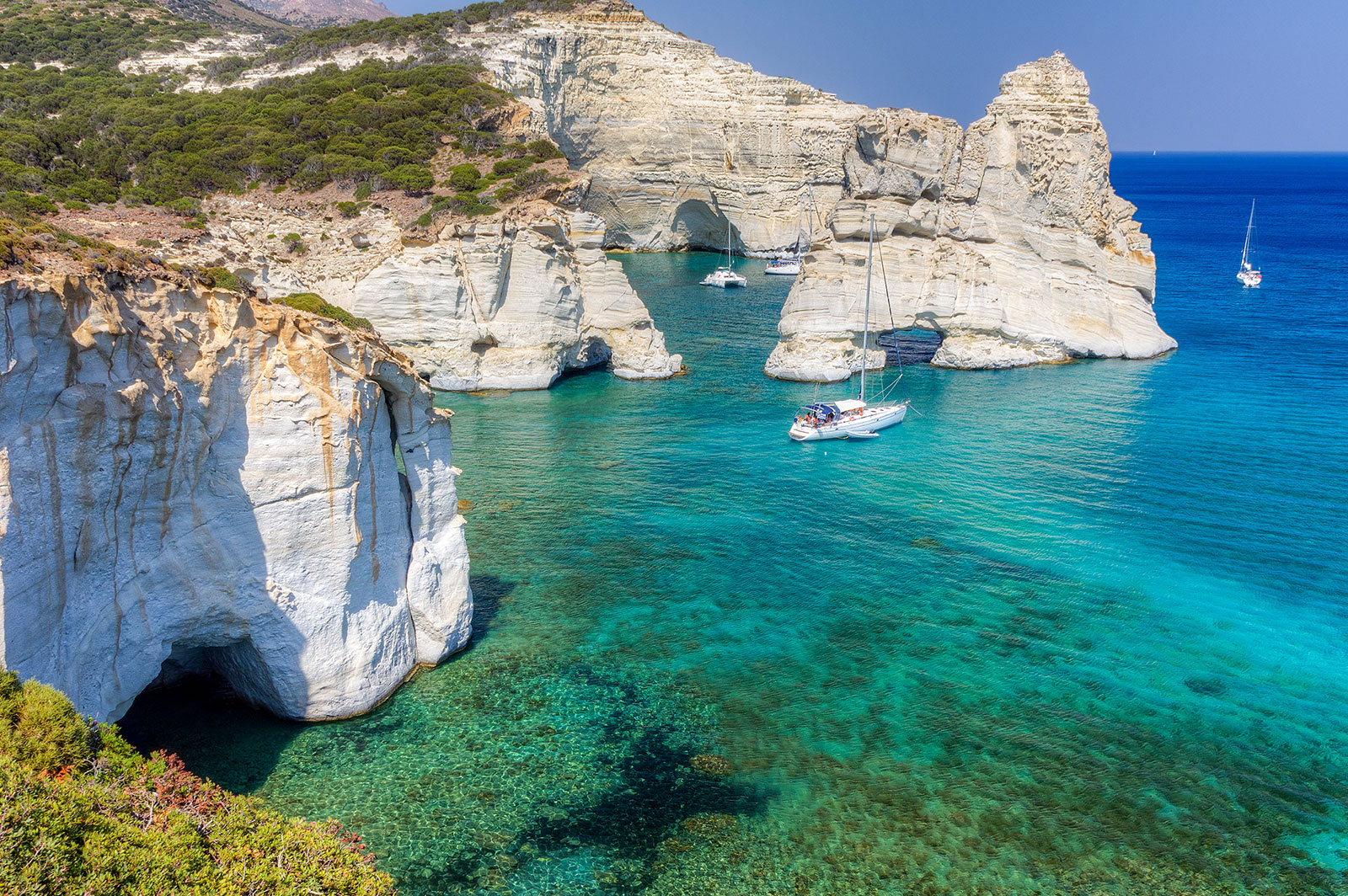
Perhaps providing the most diverse and dramatic coastline of all the Greek islands, sheltered, horseshoe-shaped Milos boasts more than 70 beaches and is heralded as the location where Venus de Milo (the ancient Greek goddess Aphrodite) was discovered. Milos has been named “the island of colors” thanks to its volcanic origin, which offers beaches and waters with a variety of colors and distinct beauty. Due to the volcanic origin of its ground, Milos presents an impressive coastal morphology and diversity. There are white-yellow beaches, bays with pebbles surrounded by stones, and white, red, yellow or black rocks. While discovering your favorite sand upon which to relax, don’t overlook Sarakiniko’s volcanic white cliffs and Papafragas’s emerald-green swimming holes and caves—shaped by the island’s unique minerals, including obsidian, barite, and sulphur, which happily bubble up in abundant hot springs.
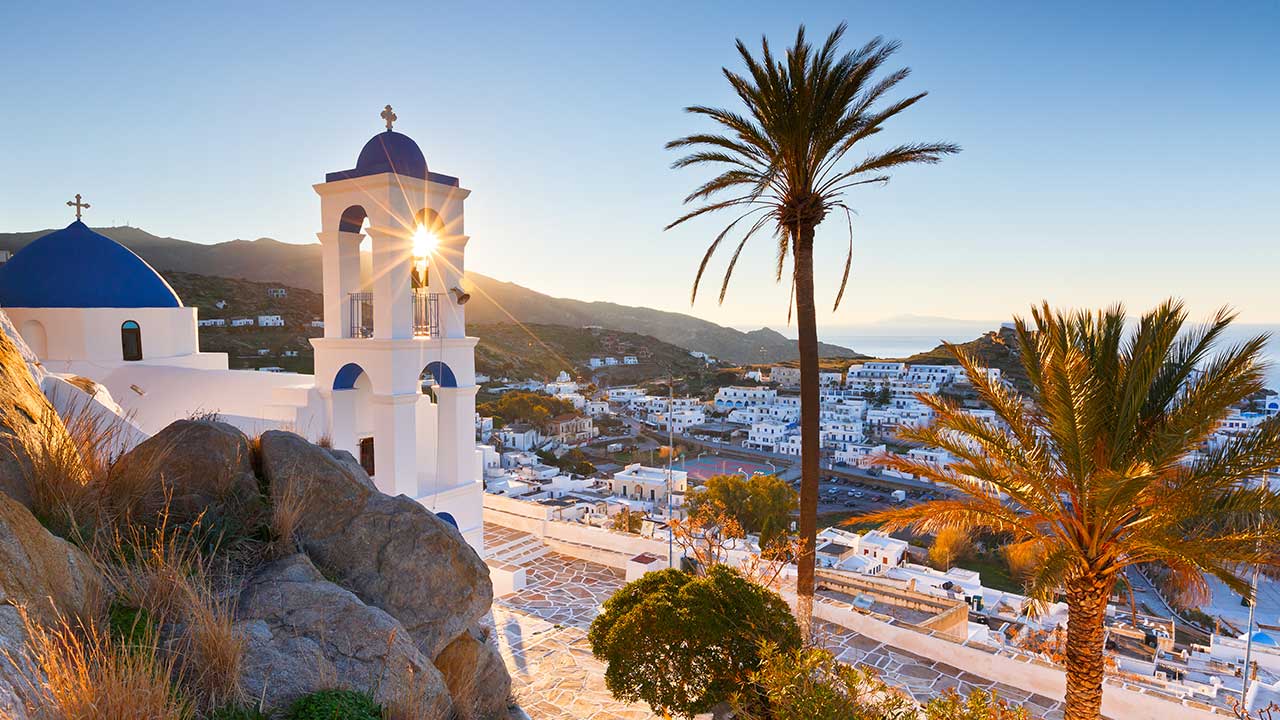
A Greek island in the Cyclades group in the Aegean Sea, Ios lies halfway between Naxos and Santorini. A hilly island with cliffs down to the sea on most sides, Ios shines for its amazing beaches, shimmering waters, and picturesque clifftop villages with narrow alleyways. Assessable by ferry or yacht, Ios is within hand’s reach of several Greek islands, including Mykonos, Naxos, Paros, and Crete. Ancient sites, museums, windmills, and churches dot the island, most notably the whitewashed church of Panagia Gremiotissa above Chora, the tomb of the Greek poet Homer in Plakoto, and the early Bronze Age settlement of Sharkos. The Archaeological Museum of Ios, displaying findings unearthed on the island, is housed in the Amiradakio Hall, located in the center of Chora.
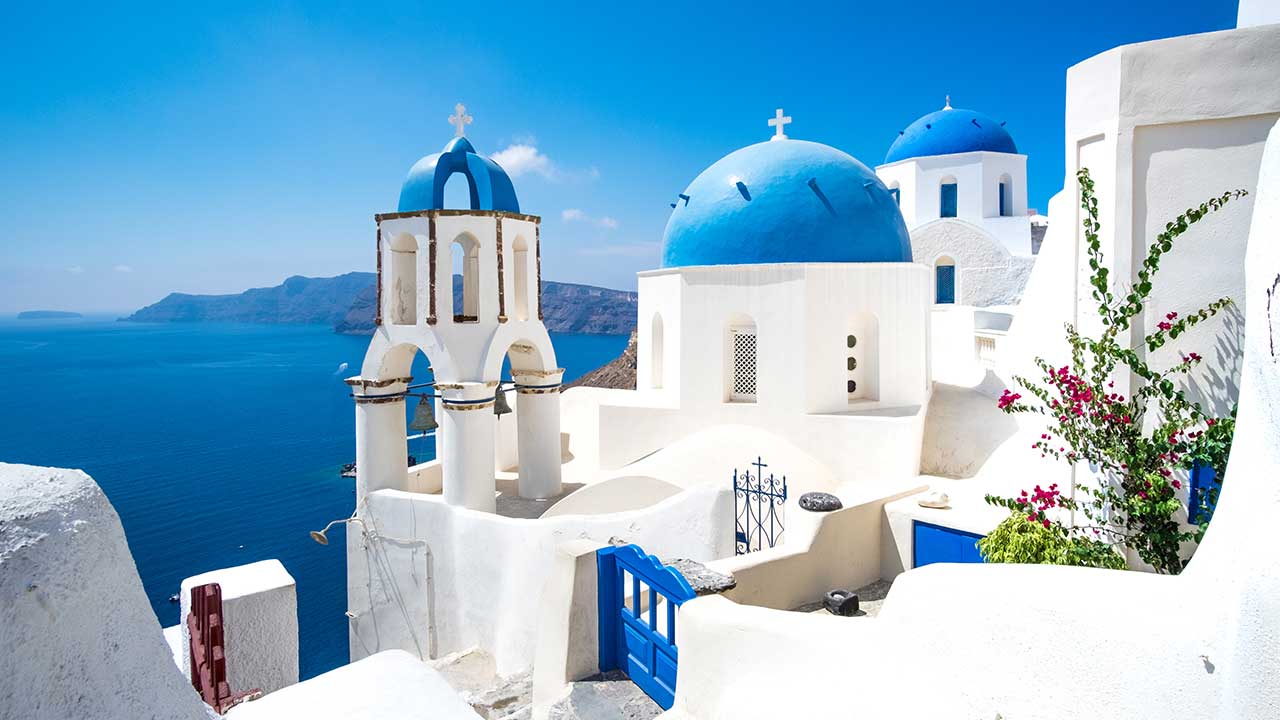
Santorini, officially named Thira, is the southernmost Greek island that is within the Cyclades archipelago, in the southern Aegean Sea. Part of the regional unit Thira, the municipality of Santorini is comprised of the island Santorini, Therasia, and other uninhabited islands of Christiana, Palaia Kameni, Aspronisi, and Nea Kameni. The geological history of Santorini is quite complex due to the area’s volcanism and is currently a water-filled caldera: a rectangular lagoon that is surrounded by three steep cliffs. The name Santorini is a contraction of the name Santa Irini, which is based on an ancient cathedral found in the island’s village of Perissa. This name was given by the Latin Empire in the 13th Century. During the Ottoman Empire, Santorini was called “Santurin” or “Santoron”, and in early times, it was named Kalliste, Strongyle, and Thera. Santorini is the site of the Minoan Eruption (also known as the Thera Eruption), one of the largest eruptions ever in recorded history. The origins of Plato’s story of Atlantis is believed to have a connection to this eruption that destroyed the early settlements on what was formerly a single island. The descriptions found of Plato’s Atlantis strongly resembles Thera, and with seismological, archaeological, and volcanological evidence, these claims are further supported. There is also speculation that the eruption is related to the Exodus of the Israelites, as well as causing the plagues described in the Bible in ancient Egypt. The economy is sustained by two principal industries: tourism and agriculture, and has recently been voted as one of the world’s most beautiful islands in various outlets such as the Traveler’s Choice Awards in 2015. The wine industry in Santorini is becoming more relevant as well, made up of Assyrtiko, Athiri and Aidani grape varieties, which is best exemplified in Vinsanto (“holy wine”) which contains all three Aegean varietals. Although Santorini is highly arid, it’s unique ecology and climate allows it to grow unique and prized produce, such as cherry tomatoes, Lathyrus clymenum (a legume), and capers. Thus, tourists indulge in local specialties such as Brantada, Fava, and the traditional dish Santorinio Sfougato.
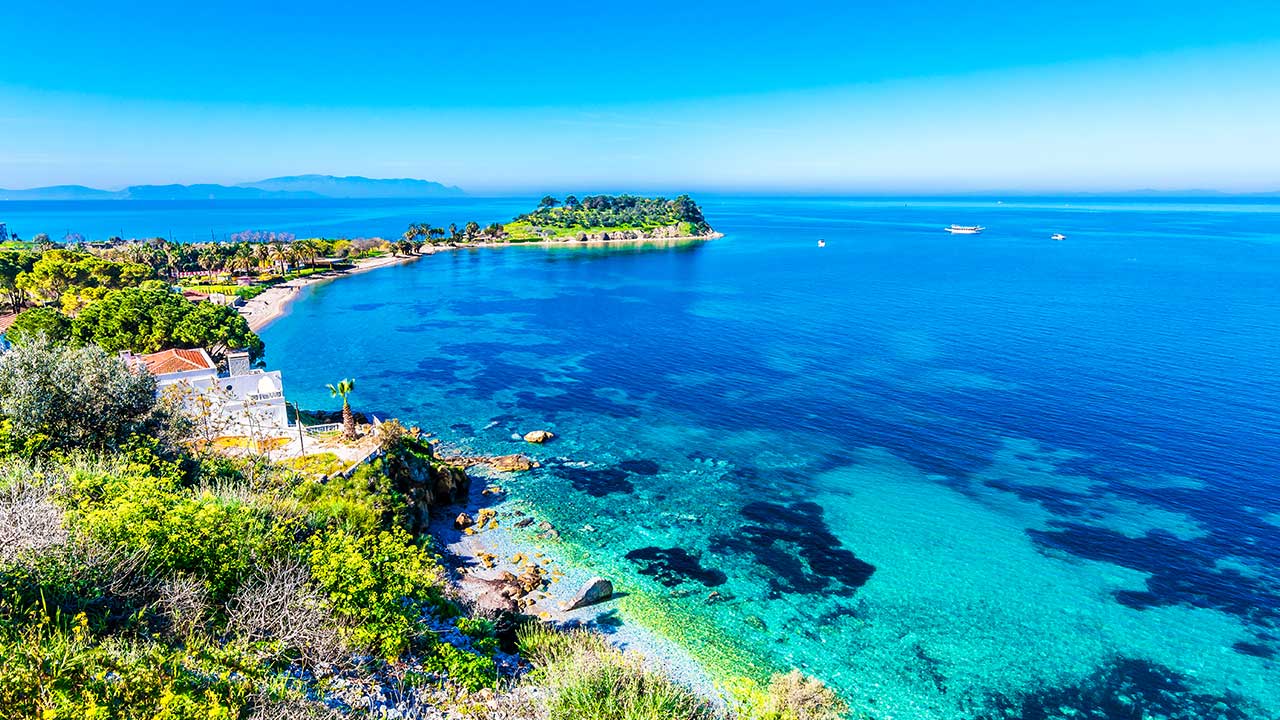
Kusadasi is a beach resort town on Turkey’s Aegean coast and the center of the seaside district of the same name in Aydin Province. The seaside town is also your gateway to the classical ruins at nearby Ephesus, among the world’s best preserved ancient Greco-Roman remains, including its excavated Terrace Houses and House of the Virgin Mary. Kusadasi’s seafront promenade, marina, and harbor are lined with quaint restaurants. Just offshore on Pigeon Island stands a walled thirteenth-century Byzantine castle that once guarded the town. Meet resident wild boars at nearby Dikek National Park, comprised of four secluded beaches, a spectacular coastline, and incomparable views of the Aegean Sea, just one of Turkey’s many protected conservation areas.
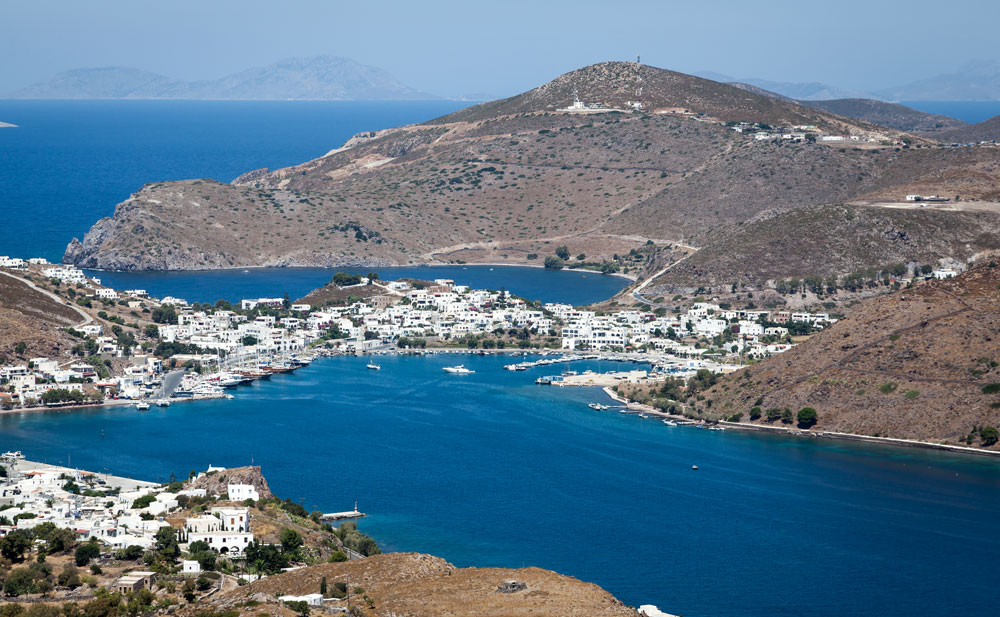
Patmos is in the South Aegean Islands, particularly a member of the Dodecanese Islands of Greece. It is north of Leros and is most known for its connection to John the Apostle from the Book of Revelations; therefore Christian pilgrims frequent this destination. In mythology, Patmos was named “Letois”, which is another named for the goddess Diana, Leto’s daughter. Since ancient authors seldom mention Patmos in early text, information on early inhabitants is limited. It is widely believed the original people of Patmos were the Carians from Asia Minor, as discovered by the earliest archaeological findings date back to the Bronze and Mycenaean periods. The mountain in the country of Caria was named Latmos, which is where historians believe the name Patmos is derived from. Dorians also colonized in Patmos, and over time, Ionians followed suit. The primary port in Patmos is Skala, which was one of the most important sea ports in the Mediterranean around the 16th century. Early Christian basilicas were constructed in the name of John of Patmos, however between the 7th and 9th century when Saracen attacks were still problematic, the Grand Royal Basilica was destroyed. A monastery began construction in 1101 when Christodoulos assumed authority over Patmos. The population began expanding as immigrants from the fall of Constantinople and Candia to place in the 15th and 17th centuries, respectively. The island was under the Ottoman rule for years and was interrupted by Venice during the Candian War, Russia during the Orlov Revolt, and Greece during their War of Independence. During the Italo-Turkish War, Italy occupied Patmos until 1943, when Nazi Germany held power over the island until 1945. Since Patmos rejoined in 1948, it has become the tranquil and frequented destination it is now. Tourists visit the Monastery of St. John, Chora, the Cave of Apocalypse, Psili Ammos Beach and other beautiful points of interest in “Europe’s most idyllic place to live,” as named by Forbes in 2009.

In ancient times, Lindos was the main hub on Rhodes. Homer tells us that it was established by the Dorians in the 12th century BC and that the city was large and powerful enough to send nine ships to the Trojan War. Towering above the village of Lindos is the ancient Acropolis. A 13th-century Crusader fortress now crowns the hill, but within its walls lie archaeological sites that date back to the 6th century BC. As you disembark from the yacht, prepare to journey through time as you explore the ancient marvels of this Greek town, a revered archaeological site steeped in history. Navigate the narrow cobblestone streets that wind their way to the base of the ancient Acropolis. Ascend the steep path and be rewarded with breathtaking views of the Doric Temple of Lindian Athena, nestled within the walls of a Crusader-era castle. From this vantage point, soak in panoramic vistas of the village, the shimmering sea, and the quaint fishing harbor of Psarto.

Symi is one of the most picturesque islands in the Dodecanese group. The backdrop of mountains that descend steeply into the sea forming beautiful bays such as Chorio takes one’s breath away. Stroll the quaint town, where every corner boasts a view of the Aegean Sea. Experience the timeless allure of the Monastery of Archangel Michael, set against a backdrop of olive groves and the tranquil Gulf of Panormos. Marvel at the monumental baroque bell tower—the world’s tallest—and discover the revered silver-plated icon of the Archangel Michael, steeped in legend.
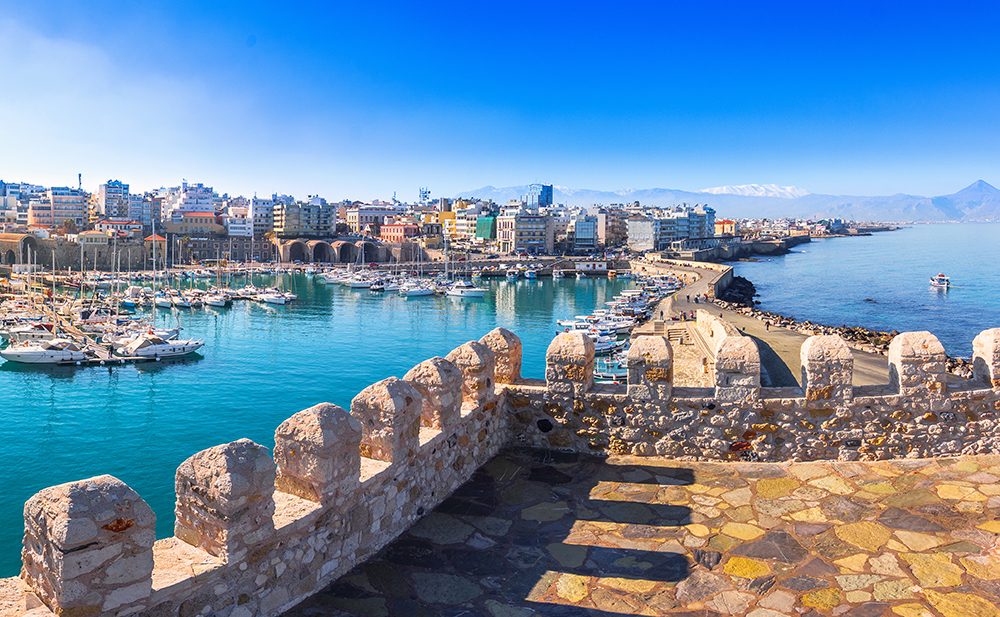
Heraklion is the capital of Crete and features abundant natural beauty, intricate architecture and so much more. The city is home to many notable archaeological finds. In the old port, visitors can tour the Castello a Mare, a Venetian fortress. The Palace of Knossos is a sight to behold and one of the largest and most significant Bronze Age archaeological sites Crete has to offer. Today, Heraklion is a lively and inviting city with an exciting nightlife. Delight at the many fascinating sights and discover the rich history of Heraklion by visiting its many museums but be sure to leave time for roaming the streets with no agenda to soak in the culture of this magnificent city.
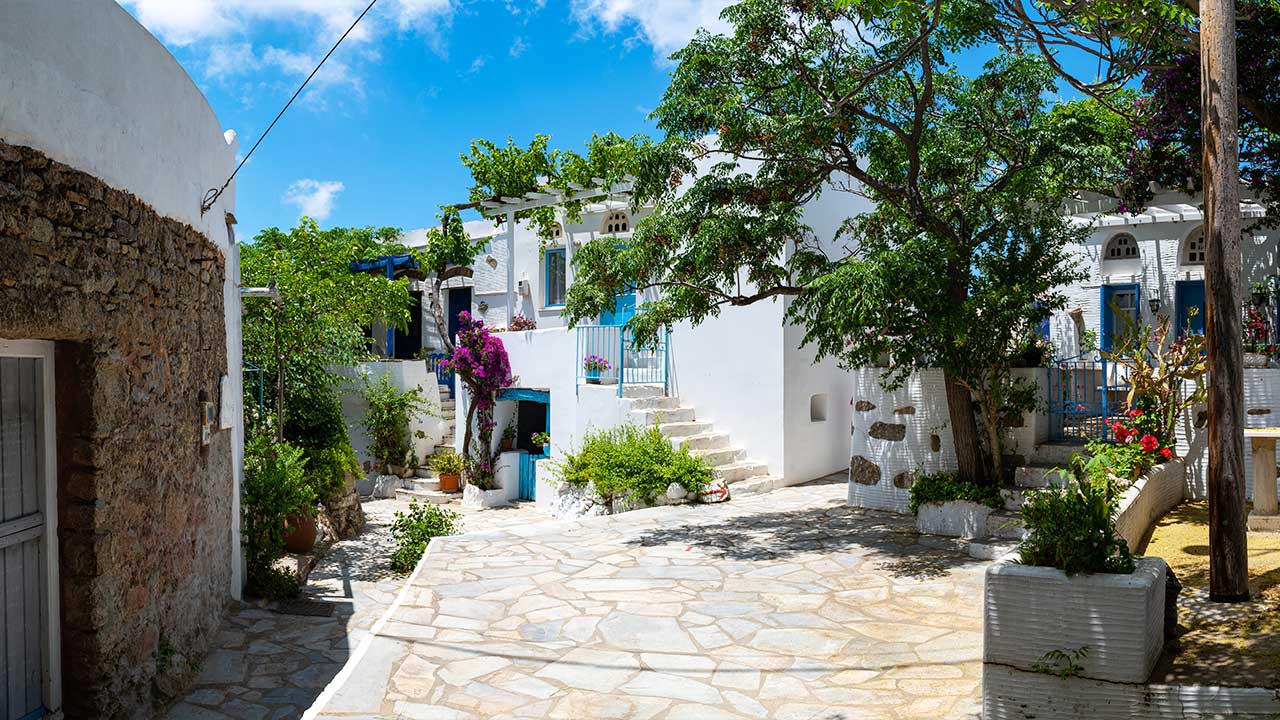
The scholar Cornelius Castoriadis called Tinos a “handmade island” for the stamp made by its signature marble-cutting artists, which elevated the island’s marble-carving tradition to new heights. As one of the Cyclades’ secret gems, Tinos offers nature lovers, art aficionados, and gastronomy enthusiasts diverse, rich experiences. Explore Tinos’ timeless treasures from Volax to Chora, delving into ancient landscapes and remarkable sites at every turn.
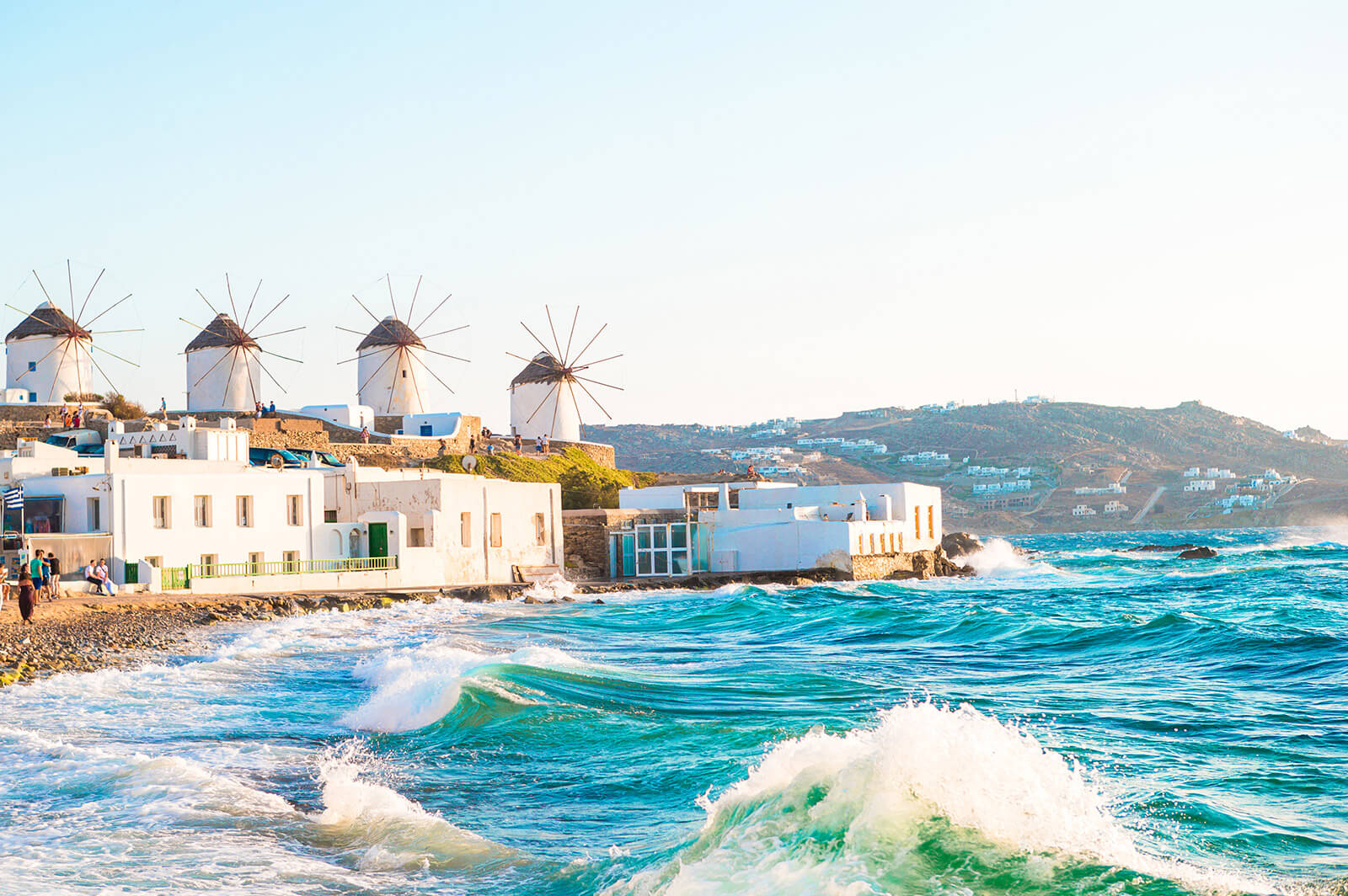
Mykonos is one of the most visited Greek Islands. It is part of the Cyclades group and lies between Tinos, Syros, Paros and Naxos. The island spans an area of 85.5 square kilometers (33.0 sq mi) and rises to an elevation of 341 meters (1,119 feet) at its highest point. Mykonos is so incredibly beautiful; it is not surprising that it has become one of the most desired destinations in the world. When you also add the cosmopolitan lifestyle, the sophisticated nightlife and the historical treasures of the nearby UNESCO Awarded Delos you’ll have the recipe for an unforgettable holiday. SeaDream usually anchors just of the famous windmills and tenders directly to the old town. Guests have a few organized options including the Sacred Island of Delos. Others may simply want to explore the island’s incredible beaches, boutiques, clubs and churches independently.
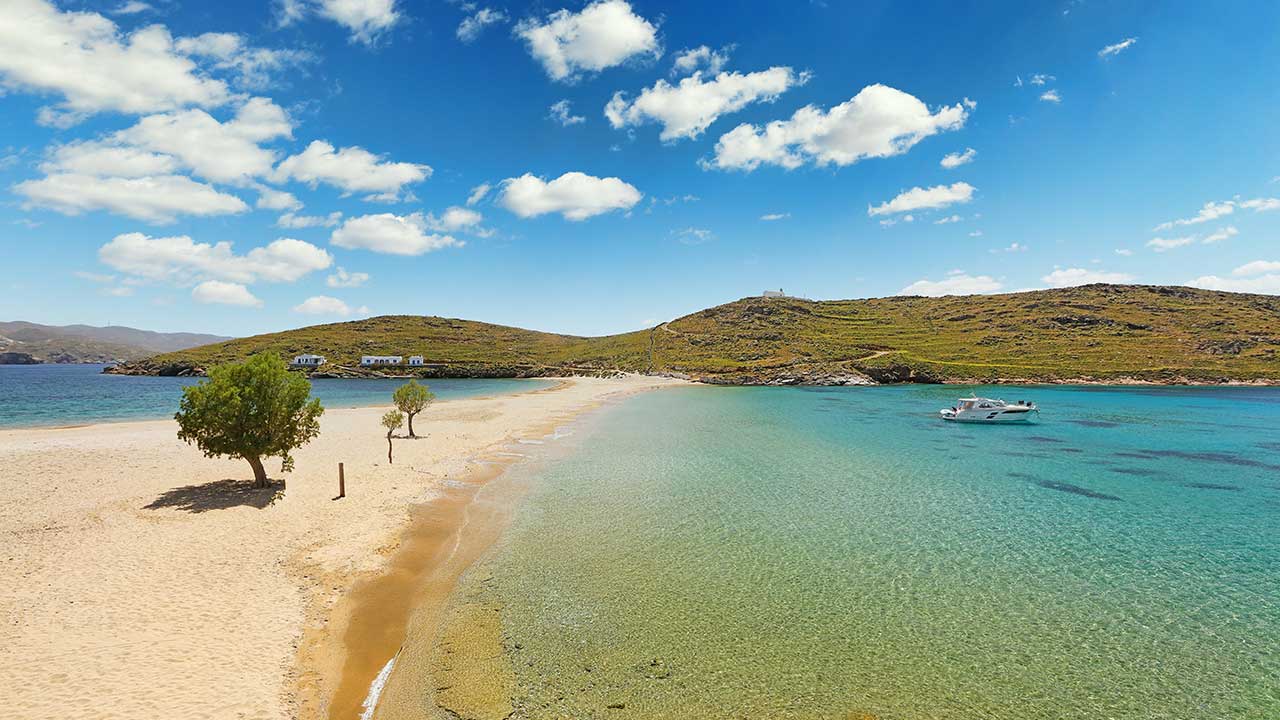
A wild natural landscape of exotic beaches nestled in the western Cyclades, Kythnos is an island of elegant simplicity and hospitality. Steeped in mythology, the island is named after Kythnos, the mythical king of the original settlers and son of the god Apollo. Bisected by ancient walls, lush valleys, and more than 100 secluded beaches, the main town of Hora and its surrounding villages shine for their elegant architecture and strollable alleyways dotted with fountains, flowers, and cozy taverns. Making its maiden call to the island in 2025, SeaDream will anchor off breathtaking Kolona Beach, a unique isthmus beach sitting between two breathtakingly beautiful bays.
Suites & Staterooms
*Single Supplement for this voyage is 200% for Yacht Club Deck 2, 3 and 4. For Commodore, Admiral and Owners Suite, a 200% single supplement rate applies.
Government, Port, Document Issuance, Handling & Service fees: $660 per guest (included)
Please Note: Fares are capacity controlled and may change without notice. The fares are per person based on double occupancy. Single and third person rates are also available. SeaDream Yacht Club strongly recommends that all guests purchase travel insurance.
Yachting Land Adventures & Activities
-
Athens (Piraeus) - Private Transfer - SIXT ride
Description
For seamless ground transportation to or from your SeaDream Yacht, we’ve partnered with SIXT ride to offer premium pre-arranged transfers. Whether you require an airport pickup, private chauffeur service, or on-demand transport, SIXT ride provides a variety of high-quality vehicle options with professional drivers, transparent pricing, and cashless convenience.
Notes
To arrange your transfer, please visit https://www.sixt.com/ride/partners/seadream
Duration
hour(s)
Price
(USD)
-
Milos - Discover Milos' Highlights
Description
Explore the impressive highlights of Milos on this concise orientation Yachting Land Adventure.
Your experience starts with a visit to the classic Cycladic village of Plaka, with cobblestone streets and white stone houses accentuated with bougainvillea flowers and located 250 meters above the Aegean Sea. Stroll through the village and admire the traditional architecture with its stunning view of the sea, particularly from the courtyard of the Korfiatissa Church.
From Plaka, reboard your coach for a drive to the idyllic landscape of Papafragas, one of the most impressive sites of Milos. From the top of the rock, it resembles a huge natural swimming pool, and its three caves were used as pirate hideouts during Byzantine times. From the overlook, admire the remnants of the imposing Cyclopean wall of ancient Phylakopi site, one of the most important settlements of the Prehistoric Aegean.
Your next stop will be Sarakiniko, an inlet of pure white stone sculpted by volcanic eruptions. This startling beautiful, out-of-this-world spot is one of the island’s many geological wonders and perhaps one of the most photographed places in the Cyclades. You have the opportunity to walk down to a point where you will encounter this one-of-a-kind beach and take photographs. You will feel as if you have landed on the moon (optional swimming).
Then, reboard the coach for the return drive to the yacht in Milos.Notes
If you desire to swim during the stop at Sarakiniko, please bring your towel from the yacht and wear your swimming clothes under your regular clothes, as there are no changing facilities. Please also return to the bus as dry as possible after swimming since it is not allowed to enter the bus with wet clothes.
A minimum participation is required to operate all Yachting Land Adventures and some have limited capacity. All adventures in the SeaDream Yachting Land Adventures program are subject to change. Final departures times will be announced onboard.Duration
3.45 hour(s)
Price
139 (USD)
Book Land Adventure -
Milos - Gastronomy of Milos (Full Day)
Description
Take the time to unwind while exploring the traditional local dishes, wine and sites across Milos Island.
Board your vehicle for a scenic drive to the picturesque village of Plaka, which impresses its visitors with its authentic charm and beauty. Here you will have the opportunity to visit an old, refurbished café, where you can indulge in traditional Greek coffee made the real way. Also sample the famous watermelon pie and other homemade delightful, sweet flavors such as the delicious dessert known as “koufeto”. The tradition and method of producing this “spoon sweet” will also be explained.
After admiring the amazing scenery of Plaka and taking memorable photos, you will head to the unique Volcanic Cave Winery, where you will sample the local wine varieties along with delicious products grown on the farm. All within a beautiful and relaxing setting, nestled between the shade of olive trees.
Continuing on, you will be offered an introduction to the authentic local gastronomy of Milos at “Alevromylos”, one of the famous restaurants in Milos. The restaurant’s chef Vassilis will further expand your horizons with an introduction to the history of “Cucina Povera” and the most famous of its products, the “Pitarakia” of Milos.
The last stop will be at the incredible volcanic swimming pool of Papafragas Cave, situated alongside the ruins of one of the most important prehistoric sites of the Aegean Sea. Afterward board the coach for the return drive to the yacht in port.Notes
August is peak season and if the restaurant is not available, then an alternative venue will be provided of similar quality providing a similar experience.
Please bring a towel from the yacht and wear your swimming suit under clothing as there are no changing room facilities. The beaches are rocky and water shoes are recommended.
A minimum participation is required to operate all Yachting Land Adventures and some have limited capacity. All adventures in the SeaDream Yachting Land Adventures program are subject to change. Final departure time will be announced on board.Duration
6.5 hour(s)
Price
399 (USD)
Book Land Adventure -
Milos - Gastronomy of Milos (Half Day)
Description
Take the time to unwind while exploring the traditional local dishes and wine across Milos Island.
Board your vehicle for a scenic drive to the picturesque village of Plaka, which impresses its visitors with its authentic charm and beauty. Here you will have the opportunity to visit an old, refurbished café, where you can indulge in traditional Greek coffee made the real way. Also sample the famous watermelon pie and other homemade delightful, sweet flavors such as the delicious dessert known as “koufeto”. The tradition and method of producing this “spoon sweet” will also be explained.
Continuing on, you will be offered an introduction to the authentic local gastronomy of Milos at “Alevromylos”, one of the famous restaurants in Milos. The restaurant’s chef Vassilis will further expand your horizons with an introduction to the history of “Cucina Povera” and the most famous of its products, the “Pitarakia” of Milos. Afterward board the coach for the return drive to the yacht in port.Notes
The tour sequence can vary to avoid congestion. A minimum participation is required to operate all Yachting Land Adventures and some have limited capacity. All adventures in the SeaDream Yachting Land Adventures program are subject to change. Final departure time will be announced on board.
Duration
4 hour(s)
Price
349 (USD)
Book Land Adventure -
Ios Island - Ios Hiking & Skarkos
Description
Learn about the early Bronze Age settlement of Skarkos on this guided hiking trip exploring Ios Island.
Ios island, known as the island of light, is located in the southern Cyclades and it’s famous for its vibrant nightlife and ancient landmarks. Starting from the port, your guide will take you on a hiking tour through the valley and towards Skarkos, one of the most important prehistoric sites in the Aegean and especially the Cyclades. This well-preserved site, dating back to 2400bc, covers an area of 1.1 hectares and is the largest and best-preserved sites of the Keros-Syros culture. At one time home to between 200 and 300 people, Skarkos is built on terraces that follow the natural relief of the hill. Reflect with the guide on the vision presented, as you learn about this civilization through the ruins witnessed at the site.
After the visit to Skarkos, you will walk deeper into the countryside of Ios, studying the landscape, reflecting on the life of the people and their historical contributions on the island. Included is a stop for a refreshment at a picturesque coffee shop, before returning through the main town and ending at the church of Hagia Irene, which welcomes the visitors to the island and where you will return to your SeaDream yacht.Notes
A minimum participation is required to operate all Yachting Land Adventures and some have limited capacity. All adventures in the SeaDream Yachting Land Adventures program are subject to change. Final departure times will be published onboard. Please wear hiking shoes or sturdy sneakers. Water will be available for you at the gangway.
Duration
3.5 hour(s)
Price
119 (USD)
Book Land Adventure -
Ios Island - Scenic Ios Island and Tasting
Description
Explore scenic vistas of Ios islands, including Homer’s Tomb and taste delicious local cheeses at a privately owned Estate.
Ios island, known as the island of light, is located in the southern Cyclades and it’s famous for its beautiful beaches and legendary night life. This is your opportunity to explore the island on a panoramic drive through the island’s beautiful scenery. You will first head to the Plakato area, in the northeast part of Ios. This is where one of the greatest poets in ancient Greece, Homer (presumed author of epics like The Odyssey and The Iliad) is now buried in his tomb. Legend has it that it was on the island of Ios where Homer took his last breath. Some say that Homer's mother, Clymene, was from Ios and that is why Homer chose to spend his last days here. You will walk uphill with your guide to view the tomb and scenic surrounding views.
Next, you will drive to the Diaseli Estate which has a cheese making tradition dating back to 1922. Back then, the cheese-making was done in stone cells (rooms) in a cauldron over the fire. You will be escorted through the Estate’s Museum by a family member where you will be introduced to the cheesery and learn about the 18th century home, the threshing floor, the agricultural tools of the last 3 centuries, as well as with a historic well. During the tour, the intricacy of the island’s history will unfold seeing exhibits owned by the family and donations from other families on the island. Your experience will end with a degustation of various local cheeses and tasting of local honey for their unique characteristics.
Leaving the Estate, you will arrive to the most picturesque Chora, sitting on a hill and crowned by whitewashed houses with blue painted doors and windows. You will have some free time here to stroll around its alleys full of geraniums and bougainvillea and enjoy amazing views of the Aegean Sea before returning to your SeaDream yacht in port.Notes
This Yachting Land Adventure must be booked 48 Hours (2 days) prior to arrival in the port to confirm its operation during your voyage. Please book on the Seadream.com website BEFORE you embark to avoid disappointment. Cancellations after the deadline are non-refundable. A minimum participation is required to operate all Yachting Land Adventures, and some may have limited capacity. All adventures in the SeaDream Yachting Land Adventures program are subject to change. Final departure times will be published on-board.
Duration
4 hour(s)
Price
225 (USD)
Book Land Adventure -
Santorini - Akrotiri Archaeological Site & Oia Village
Description
On this land adventure, discover the picturesque village of Oia and one of the most important prehistoric settlements of the Mediterranean: Akrotiri Archaeological site. Could Akrotiri be the lost city of Atlantis?
One of the reasons Santorini has attracted the world’s attention is the excavation at Akrotiri, which reclaimed a whole prehistoric Minoan city from the volcanic ash. The prehistoric site of Akrotiri is on the south-western tip of the island and was discovered in 1967 by Professor Spyros Marinatos. The city was buried by the Theran volcanic eruption in the middle of the second millennium BC.
Over the years, excavations have brought into light a remarkably well-preserved site with two and three-story homes decorated with marvelous wall paintings and frescoes, an advanced drainage system and many interesting objects, artwork, pottery and furniture which give a picture of a society which was very well organized and at the peak of prosperity. This was interrupted suddenly by the eruption of the volcano, which buried the entire city. An ambitious modern bio-climatic roof top structure protects this important archaeological settlement where excavation works are still in progress.
After exploring the excavations with a guide, ride to the northeast part of the island and its most picturesque town, Oia. Built high up on the ridge of red rocks, it offers breathtaking views of the blue Aegean. Take a stroll around the narrow streets with the old beautiful houses and the tiny picturesque shops. Enjoy the breathtaking views of the caldera cliff and wander in the narrow streets for shopping or a cup of coffee during your free time in the village.
The guide visit ends in the town of Fira. Wander along the edge of the caldera for amazing views or wander through narrow streets with the various shops. When ready, take a cable car or walk along the path down to the small port of Skala Fira for tenders back to the SeaDream yacht.Notes
A minimum participation is required to operate all Yachting Land Adventures, some have limited capacity. All adventures in the SeaDream Yachting Land Adventures program are subject to change.
Duration
4 hour(s)
Price
179 (USD)
Book Land Adventure -
Santorini - Islands of Santorini Caldera by Private Catamaran
Description
Cruise the caldera and its volcano on a private luxury catamaran whilst enjoying the stunning views together with refreshments.
Transfer by tender to the pier in Vilhada where the captain and crew wait for your private catamaran cruise. Enjoy wine, beer, soft drinks, and appetizers on board throughout the sailing.
Take in the sea breezes and beautiful views while sailing past Red Beach, White Beach, the rock formations of Akrotiri and the lighthouse. Coming into view next will be the volcanic islands formed around 1570 BC.
Next, disembark and enjoy the beautiful otherworldly surroundings on the island of Nea Kameni. Take the opportunity to relax on the beach or walk up to the island’s crater and visit the natural hot springs, which have waters that are green and yellow due to their mineral content.
After exploring the village, board the catamaran for a journey back to the old port to tender back to the SeaDream yacht.Notes
A minimum participation is required to operate all Yachting Land Adventures and some have limited capacity. All adventures in the SeaDream Yachting Land Adventures program are subject to change. Final departure time will be announced on board.
Hat, sunscreen and good walking shoes are recommended. If you opt to swim in the natural hot springs; please be advised that the mineral content in the water can stain your clothes.Duration
4 hour(s)
Price
549 (USD)
Book Land Adventure -
Kusadasi (Ephesus) - Delicious Discoveries and Turkish Cooking Class
Description
Experience the charm of the quaint Greek village of Sirince, followed by a unique culinary workshop set in a stunning Turkish hillside location.
Enjoy a scenic drive to the old Greek Village of Sirince, famous as the perfect synthesis of Turkish and Greek culture, and world-famous Turkish hospitality.
From a distance the village resembles a painting and the winding cobbled streets are lined by two story homes which are under preservation and building is no longer permitted. Stroll through the streets where the houses are kept in Greek style on the outside, while the interiors are distinctly Turkish. Due to its location in a fertile valley the village is renowned for the fresh produce and local olive oil used in the delicious dishes produced there.
Your guide will escort you to the hillside Hotel Nisanyan where you will enjoy the chance to learn about the art and style of Turkish cuisine whilst cooking, chatting, and absorbing the atmosphere of Sirince's special cooking workshop. At the heart of this excursion is the herb garden, and the beautiful hotel which is managed by a renowned family with extensive knowledge of Turkish cuisine, which they love to share. Prepare and cook your own lunch from scratch and later enjoy the dishes you have cooked with your own hands, along with a glass of Turkish wine. Afterwards return to Kusadasi, where you will have the option to take part in a colourful presentation of Turkish carpets or alternatively return to the yacht at your leisure.Notes
A minimum participation is required to operate all Yachting Land Adventures, and some may have limited capacity. All adventures in the SeaDream Yachting Land Adventures program are subject to change. Final departure times will be published on-board.
Duration
5.45 hour(s)
Price
259 (USD)
Book Land Adventure -
Kusadasi (Ephesus) - Ephesus & the Elite's Terraced Houses
Description
Uncover the UNESCO World Heritage site, Ephesus, on this guided private excursion that also features a visit to the affluent homes at the famous Terrace Houses.
Meet your guide and depart the pier for a scenic drive to the ancient city of Ephesus, one of the largest and most important cities in the ancient Mediterranean world. Second only to Constantinople, it is estimated that roughly 15% of the total city has been excavated. Situated on the western coast of Asia Minor (modern day Turkey), it was one of the oldest Greek settlements on the Aegean Sea and later became the provincial seat of the Roman government in Asia.
Your guided walking tour will start at the upper gate of Ephesus, as you explore the unending monuments including the Forum, the Odeon, the Library of Celsus, Hadrian’s Temple, the Thermal Baths of Scolastika and the Great Theater, built in the Greek era and reconstructed in the Roman period.
You also visit the spectacular Terrace Houses (villas) located on the side of the hill within Ephesus. They have a fantastic view of the entire city of Ephesus. The Ephesus Terrace Houses reveal how wealthy Romans lived during the city’s glory days. Glass floors let you admire geometric mosaics and still-colorful frescoes gleaming on the walls. The Terrace Houses were discovered by a team of Austrian archeologists during excavations in the 1980’s. Along with the ruins in Pompeii, they constitute some of the most vivid examples of Roman domestic architecture to survive today. Reflect on the lives in the city and homes of Ephesus as you return by coach to your yacht in Kusadasi.Notes
This excursion involves extensive walking and stair climbing at the Terrace Houses, comfortable shoes with non-slip soles are recommended. At Terrace Houses, guests will walk on glass-covered platforms. A minimum participation is required to operate all Yachting Land Adventures, and some may have limited capacity. All adventures in the SeaDream Yachting Land Adventures program are subject to change. Final departure times will be published on-board. Order of sights visited may vary to avoid congestion.
Duration
3 hour(s)
Price
139 (USD)
Book Land Adventure -
Patmos - A Photographic View of Patmos
Description
Take the opportunity to capture unique images of Patmos Island and its daily life with your camera.
This tour, covering the south side of the island, not only gives you the opportunity of discovering hidden places but also an opportunity to photograph the most amazing land and seascapes along with developing your creative eye, composing images from geometric form and abstract pattern.
The tour commences from the Port of Skala by minibus to the old village of Chora, the island’s capital, and a photographer’s paradise! The first experience is a wonderful panoramic view over the island. With a turn or your head, you get a glimpse of the 11th century monastery built like a fort, standing with proud dominance. Your guide takes you through Chora’s labyrinth of winding cobbled streets and maze of arched alleyways which offer a feast of photographic inspiration. Observe the settlement of houses dating from the fifteen hundreds with their white-washed walls, reflecting the light, casting shadows and creating geometric patterns. The alleys, arches and doorways display a harmonious balance revealing subtle architectural details which, through your lens, can become exciting atmospheric images trapped in time.
Next, make your way descending to Diakofti stopping off to photograph the view of the mystical rock of Petra and then on to a boatyard. Here you will have the opportunity to photograph the local islanders at work and the streamline shapes of vessels in dry dock. You will also have the chance to enjoy a refreshment at a local café. Fulfilled with great images and pictures in your photo camera you will return to Skala port.Notes
Be sure to wear comfortable walking shoes, as there is extended walking over uneven surfaces and through narrow streets on this excursion. A minimum participation is required to operate all Yachting Land Adventures and some have limited capacity. All adventures in the SeaDream Yachting Land Adventures program are subject to change. Final departure time will be announced on board
Duration
3.5 hour(s)
Price
189 (USD)
Book Land Adventure -
Patmos - A Photographic View of Patmos "ADDITIONAL SPACE"
Description
**Due to the popularity of this Yachting Land Adventure, additional space for prebooking has been added on this voyage.**
Take the opportunity to capture unique images of Patmos Island and its daily life with your camera.
This tour, covering the south side of the island, not only gives you the opportunity of discovering hidden places but also an opportunity to photograph the most amazing land and seascapes along with developing your creative eye, composing images from geometric form and abstract pattern.
The tour commences from the Port of Skala by minibus to the old village of Chora, the island’s capital, and a photographer’s paradise! The first experience is a wonderful panoramic view over the island. With a turn or your head, you get a glimpse of the 11th century monastery built like a fort, standing with proud dominance. Your guide takes you through Chora’s labyrinth of winding cobbled streets and maze of arched alleyways which offer a feast of photographic inspiration. Observe the settlement of houses dating from the fifteen hundreds with their white-washed walls, reflecting the light, casting shadows and creating geometric patterns. The alleys, arches and doorways display a harmonious balance revealing subtle architectural details which, through your lens, can become exciting atmospheric images trapped in time.
Next, make your way descending to Diakofti stopping off to photograph the view of the mystical rock of Petra and then on to a boatyard. Here you will have the opportunity to photograph the local islanders at work and the streamline shapes of vessels in dry dock. You will also have the chance to enjoy a refreshment at a local café. Fulfilled with great images and pictures in your photo camera you will return to Skala port.Notes
Be sure to wear comfortable walking shoes, as there is extended walking over uneven surfaces and through narrow streets on this excursion. A minimum participation is required to operate all Yachting Land Adventures and some have limited capacity. All adventures in the SeaDream Yachting Land Adventures program are subject to change. Final departure time will be announced on board
Duration
3.5 hour(s)
Price
189 (USD)
Book Land Adventure -
Patmos - The Monastery of St. John & Patmian House
Description
Explore the UNESCO-listed Monastery of St. John the Theologian, the divine Grotto, and experience a glimpse of a traditional Patmian home.
Patmos is often called the Jerusalem of the Aegean, the sacred island where St. John wrote the Book of Revelations in the Bible. Depart from the pier today for a short scenic ride to Chora and the UNESCO-listed Monastery of St. John the Theologian, built high on an ancient acropolis. The monastery's massive 15th-century walls and 17th-century battlements loom over the town belying an intimate and peaceful interior of arches, inlaid pebble stone floors, and whitewashed buildings. The charming chapel of Christodoulos is profusely decorated with frescoes and the old treasury, now a museum, displays a breathtaking collection of jeweled chalices, crowns, crucifixes, vestments and ancient manuscripts.
Travel on to the Grotto of St. John where the saint heard the voice of God and wrote his revelations. It was here, the most sacred spot on the island, where St. John the Theologian spent 16 months in exile, and this simple cave is now a chapel and place of pilgrimage. Both the Cave and the Monastery have been UNESCO listed in 1999. The iconostases built into the cave depict St. John's visions and the spots where the saint slept, wrote, and heard "a great voice, as of a trumpet."
Back in Chora you will visit one of the traditional Patmian houses, the house of the Simantiris family. The magnificence of Patmian home interiors is stunning. Entering the thick wooden entrance door is like stepping into another dimension, with Venetian style furniture, handicrafts and multi-colored mosaic ceilings dating from the 18th century. After your visit, drive through the town of Chora on the way back to SeaDream in Patmos.Notes
Proper (modest) dress code is required for the monastery and the Grotto. Women should wear skirts covering their knees and blouses covering their shoulders. Men should wear long pants and shirts covering their shoulders. This land adventure includes some uphill walking as well as steps in the upper town of Chora, the local home and at the Grotto. Therefore, flat and comfortable walking shoes are highly recommended.
A minimum participation is required to operate all Yachting Land Adventures and some have limited capacity. All adventures in the SeaDream Yachting Land Adventures program are subject to change. Departures times will be published onboard.Duration
3.5 hours hour(s)
Price
149 (USD)
Book Land Adventure -
Lindos, Rhodes - Grand Masters' Legacy & Old Rhodes Town Stroll
Description
Embark on a journey through time as you explore the enchanting streets of Old Rhodes town and marvel at the awe-inspiring Palace of the Grand Masters.
Departing from the pier, your adventure begins with a picturesque one-hour drive through charming villages adorned with white-washed houses, nestled amidst olive groves and orchards. Standing proudly at the culmination of the Street of the Knights, the Palace of the Grand Masters awaits your arrival, a testament to the grandeur of medieval Rhodes. Dating back to the 14th century, its distinctive architecture and timeless allure are sure to leave you captivated.
Stroll along the historic Street of the Knights, adorned with vibrant shops, and behold the magnificent 15th-century Hospital of the Knights, now home to the Archaeological Museum. After an immersive guided tour, take a moment to refresh and rejuvenate at a local establishment.
As the tour draws to a close, rejoin your coach for a scenic journey back to Lindos, enriched with memories of a bygone era and the legacy of the Grand Masters.Notes
A minimum participation is required to operate all Yachting Land Adventures, and some may have limited capacity. All adventures in the SeaDream Yachting Land Adventures program are subject to change. Final departure times will be published on-board.
Duration
4.5 hour(s)
Price
239 (USD)
Book Land Adventure -
Lindos, Rhodes - The Acropolis of Lindos
Description
Discover Lindos with an expert guide. Explore the ancient Acropolis and wander its charming streets lined with traditional houses and vibrant shops.
As you disembark from the yacht, prepare to journey through time as you explore the ancient marvels of Lindos, a revered Archaeological site steeped in history. Led by your knowledgeable guide, navigate the narrow cobblestone streets that wind their way to the base of the ancient Acropolis. Ascend the steep path and be rewarded with breathtaking views of the Doric Temple of Lindian Athena, nestled within the walls of a Crusader-era castle. From this vantage point, soak in panoramic vistas of the village, the shimmering sea, and the quaint fishing harbor of Psarto, steeped in legendary tales of St. Paul's arrival to spread Christianity to the region.
After immersing yourself in Lindos' rich history, take leisurely strides through the picturesque village, adorned with whitewashed houses and charming shops. Absorb the essence of this captivating locale before your return journey to the pier, leaving with memories of Lindos' timeless allure.Notes
Strenuous activity involved. Please wear casual attire and comfortable walking shoes, as you'll encounter 195 steps when visiting the fortress. A minimum participation is required to operate all Yachting Land Adventures and some have limited capacity. All adventures in the SeaDream Yachting Land Adventures program are subject to change. Final departure time will be announced on board.
Duration
2.5 hour(s)
Price
129 (USD)
Book Land Adventure -
Symi - Panormitis: The Monastery of Archangel Michael
Description
Experience the timeless allure of Panormitis, the Monastery of Archangel Michael on Symi Island, Greece. Set against a backdrop of olive groves and the azure Gulf of Panormos, this iconic sanctuary beckons pilgrims and visitors worldwide.
Marvel at the monumental baroque bell tower—the world's tallest—and discover the revered silver-plated icon of the Archangel Michael, steeped in legend and miracles. Delve into centuries of history as you explore the monastery's meticulously restored 18th-century architecture, adorned with intricate frescoes and elaborate chandeliers. This is a unique opportunity to engage privately with a monk from the monastery, gaining insight into their devoted way of life. Partake in a timeless ritual as you illuminate a candle and offer a heartfelt prayer within the tranquil confines of this sacred church. Depart the monastery with a cherished memento from the monk, a tangible reminder of the profound experience you've encountered.
Embark on a journey of discovery at Panormitis, the Monastery of Archangel Michael—a sanctuary of faith, beauty, and tranquility on this memorable Yachting Land Adventure.Notes
Comfortable walking shoes are required. Appropriate dressing is required for the visit to the Monastery. Gentlemen must be in long trousers and ladies must be in skirts or long slacks.
This Yachting Land Adventure must be booked 7 days prior to arrival in the port to confirm its operation during your voyage. Please book on the Seadream.com website prior to embarkation to avoid disappointment. Cancellations after this booking deadline are non-refundable. A minimum participation is required to operate all Yachting Land Adventures, and some may have limited capacity. All adventures in the SeaDream Yachting Land Adventures are subject to change. Final departure times will be published on-board.Duration
3.5 hour(s)
Price
249 (USD)
Book Land Adventure -
Symi - Symi Stroll
Description
Explore Symi's neoclassical mansions and charm. Delve into its history at the Archaeological Collection and descend to Yialos via the scenic Kali Strata to witness Symi's rich maritime heritage.
At the pier, you will be transferred to the heart of Symi Island at Ano Symi, also known as Horio, where 18th and 19th-century neoclassical mansions line the picturesque streets. Stroll with your guide through the charming maze of alleys, adorned with modest houses showcasing asymmetrical architecture and neo-classical embellishments. Delve into history at the Archaeological Collection of Symi, housed in a traditional Symian mansion, featuring ancient sculptures, urns, and a diverse range of artifacts across five dedicated sections.
Pause for a moment to enjoy a refreshment at a traditional café in Horio under the shade of an ancient tree before embarking on a scenic descent to Yialos via the Kali Strata, a stone stairway of 450 steps boasting breathtaking views. Admire the colorful houses and intricate interiors, adorned with decorative ceilings, skylights, and neoclassical elements. Learn about Symi's rich maritime heritage, once thriving with shipbuilding and sponge diving, a trade pioneered by Symian inhabitants. Witness the legacy of the island's sponge divers at Yialos, where the statue of the little fisherman Michalakis stands as a testament to Symi's storied past.Notes
Wear comfortable walking shoes and the tour sequence may vary. A minimum participation is required to operate all Yachting Land Adventures, and some may have limited capacity. All adventures in the SeaDream Yachting Land Adventures program are subject to change. Final departure times will be published on-board.
Duration
2.5 hour(s)
Price
179 (USD)
Book Land Adventure -
Heraklion, Crete - Cretan Villages and Traditions
Description
Crete is an island of contrasts. Cosmopolitan and over developed in some parts, rough and unspoiled and wild in other parts. When traveling through the interior, notice the scenery is constantly changing and includes harsh barren land as well as lush woods.
Depart the city of Heraklion for the hillside village of Thrapsano. This village is renowned throughout Crete for its traditional pottery workshops and still produces the traditional storage jars ("pitharia") little changed from the Minoan era. Watch the local potters at work and admire their traditional pottery making techniques.
Continue on to the village of Peza which has been at the center of one of the most important wine growing areas of Crete since Minoan times. See the traditional vineyards and visit the winery before sampling some of the local produce.
At the end of the visit, enjoy a panoramic drive of the city of Heraklion before returning to the pier.Notes
A minimum participation is required to operate all Yachting Land Adventures and some have limited capacity. All adventures in the SeaDream Yachting Land Adventures program are subject to change. Final departures times will be announced onboard.
Duration
4 hour(s)
Price
149 (USD)
Book Land Adventure -
Heraklion, Crete - Knossos Palace & Archaeological Museum
Description
Knossos was the court of the legendary King Minos, whose wife Pasiphae gave birth to the Minotaur, half-bull, half-man. The excavations on the site were begun by the English archaeologist Sir Arthur Evans and his team in 1893 and lasted 35 years.
Entering the Great Palace through the West Court, it is easy to understand why the legend of the labyrinth originated here. It takes about one hour and a half to walk around the site and explore all the parts of the Palace. During this walking tour, admire in the superb Royal Quarters the Throne room with an Antechamber and main throne and the Queen’s Quarters whose wall above the entrance door is decorated with a copy of the famous dolphin frescoes. Apart from the Royal Palace there are also other buildings included in the site such as the Small Palace, the House of the High Priest and the Caravanserai.
This excursion also includes a visit to one of the most interesting and richest museums in the world, the Archaeological Museum in Heraklion. This Museum houses nearly all the finds from the Minoan era including the marvelous frescoes form the Royal Palace of Knossos.Notes
A minimum participation is required to operate all Yachting Land Adventures and some have limited capacity. All adventures in the SeaDream Yachting Land Adventures program are subject to change. Final departures times will be announced onboard.
Sunscreen, hats and comfortable walking shoes are recommended.Duration
4 hour(s)
Price
169 (USD)
Book Land Adventure -
Tinos - Timeless Treasures of Tinos
Description
Explore Tinos' timeless treasures from Volax to Chora, delving into ancient landscapes and remarkable sites on this enriching guided tour.
Depart on this enchanting journey through Tinos Island's timeless treasures. Explore Volax, a village steeped in 2,000 years of history, adorned with unique granite formations and skilled artisans crafting traditional baskets.
Continue to Pyrgos, Tinos' largest traditional village, where Venetian towers stand tall amidst a legacy of marble craftsmanship. Visit marble workshops, galleries, and the Marbleworking Museum before indulging in a coffee break in the marble-clad square.
You have an option to return to the yacht or linger in Chora to uncover its hidden gems and return to the yacht independently. Experience Tinos' captivating blend of tradition and wonder on this Yachting Land Adventure!Notes
Wear casual clothing and comfortable walking shoes. A minimum participation is required to operate all Yachting Land Adventures, and some may have limited capacity. All adventures in the SeaDream Yachting Land Adventures program are subject to change. Final departure times will be published on-board.
Duration
4 hour(s)
Price
209 (USD)
Book Land Adventure -
Tinos - Tinos Hillside Hike & Village Delights
Description
Discover Tinos' essence on a journey from its pier to Exomvourgo Hill, hiking past ancient ruins and picturesque villages while savoring local delicacies.
Embark on this enchanting journey from Tinos pier to the captivating Exomvourgo Hill, the third highest peak on the island, boasting ancient ruins of a Venetian castle steeped in a millennia of history. Descending through verdant trails, you will arrive at the quaint village of Koumaros, renowned for its picturesque charm and unique self-service café operating 24/7 without staff.
The route then leads you to the extraordinary village of Voláx, nestled amidst enigmatic spherical rocks of unknown origin, where you pause for a delightful break with Greek coffee, homemade lemonade, and local sweets. Experience the essence of Tinos in this unforgettable tour.Notes
Hiking distance is 2.5 km (approximately 1.5miles). Be sure to wear sturdy walking shoes and comfortable clothes. A minimum participation is required to operate all Yachting Land Adventures, and some may have limited capacity. All adventures in the SeaDream Yachting Land Adventures program are subject to change. Final departure times will be published on-board.
Duration
4.5 hour(s)
Price
189 (USD)
Book Land Adventure -
Mykonos - A Relaxing Day at the Beach
Description
Swim, relax and enjoy the beach facilities at one of the most beautiful and sandy beaches of Mykonos Island – Elia beach.
Mykonos is known for its golden sandy beaches and crystal clear waters. Take this opportunity to enjoy some time at one of the famous beaches of the island, the sandy beach of Elia where necessary changing facilities, beach chairs and umbrellas are available. The beach of Elia is fully organized offering also a wide choice of water sports facilities.Notes
Sunscreen and hats recommended.
A minimum participation is required to operate all Yachting Land Adventures and some have limited capacity. All adventures in the SeaDream Yachting Land Adventures program are subject to change. Final departure time will be announced on board.Duration
4 hour(s)
Price
149 (USD)
Book Land Adventure -
Mykonos - The Sacred Island of Delos
Description
This Yachting Land Adventure arrives at Delos Island by a boat from Mykonos. Delos is the island of lights and the mythical birthplace of the God Apollo. Admire the interesting monument of the Agora, the treasures of the various cities, the theatre and the Sanctuary of Apollo.
Not far from Mykonos lies UNESCO listed Delos, the island of light, the mythical birthplace of the God Apollo and the Goddess Artemis. Its name means “that which appears" and, according to mythology, the island appeared amid the waves so that Leto would have a place to give birth to Apollo and Artemis. Delos Island, an area of only five sq. km (almost 2 sq. miles), was once a very important religious, cultural and commercial center. Today, the island is a piece of land covered with archaeological sites: fallen columns, sections of the famous mosaics which adorned the houses of the rich, a stadium, and tiers of seats from a theatre. Among these ruins, five marble lions in a row still stand. These were the guardians of the sacred lake, still gazing out to the east waiting for the sun to rise.
Other interesting monuments, spread over a wide area, are: the Agora, the treasuries of the various cities, the Sanctuary of Apollo, the Theatre, the Sanctuary of the Foreign Gods and the Sacred Mt Cynthus. Leaving the sacred island of Delos you re-board your local boat for the 45-minute return to Mykonos town.Notes
This land adventure operates from Mykonos only if the yacht does not call at Delos on the same itinerary. This visit includes a two-hour walk across uneven surfaces at the archaeological sites so please wear comfortable walking shoes. The departure time will be adjusted according to the departure time of the local boat schedule from Mykonos to Delos. There is very limited shade at the site so bring protection from the sun. There is a coffee kiosk on the island as well as restrooms near the pier on Delos. A minimum participation is required to operate all Yachting Land Adventures and some have limited capacity. All adventures in the SeaDream Yachting Land Adventures program are subject to change. Departures times will be published onboard
Duration
3,5 hour(s)
Price
139 (USD)
Book Land Adventure -
Kythnos - Kythnos Aqua Safari by Rib
Description
Embark on an awesome snorkeling adventure via rib boat discovering amazing treasures in the depths of Kythnos' underwater realm.
From the pier, enjoy a scenic 15-minute drive to Loutra village where your seasoned instructor will provide a comprehensive briefing and your snorkeling gear before boarding the private rib boat. Cruise from this seaside village to an exclusive snorkeling haven, where you'll plunge into crystalline waters to uncover hidden marvels, including unusual rock formations and vibrant coral reefs. After an awe-inspiring experience, you return to Loutra village, leaving you with cherished memories as you return to your yacht at the port.Notes
This Yachting Land Adventure MUST be prebooked on Seadream.com 7 days before arrival in the port to confirm your spot. Refunds won't be issued for cancellations after this deadline. However, if the tour is canceled due to weather or sea conditions by the operator, you will receive a refund.
Wear your swimwear under your clothes, bring a towel from the yacht, and apply sunscreen. The snorkeling boat has no shade, so remember to also wear sunglasses and a hat for protection. A minimum participation is required to operate all Yachting Land Adventures, and some may have limited capacity. All adventures in the SeaDream Yachting Land Adventures are subject to change. Final departure times will be published on-board.Duration
3 hour(s)
Price
249 (USD)
Book Land Adventure
Prices are per person, in USD. Duration is in hours.
Testimonials
Everything from service to cuisine was first class. It is truly an experience we will never forget-we will return to take another voyage with you. Jerry & Catherine A.Ohio
We have done other small ships in the past, but you guys take it to a higher level. We were very happy with everything, Ship, Captain, Crew, Cuisine, just outstanding and made us feel like family! Mr. & Mrs. HartNew Mexico

